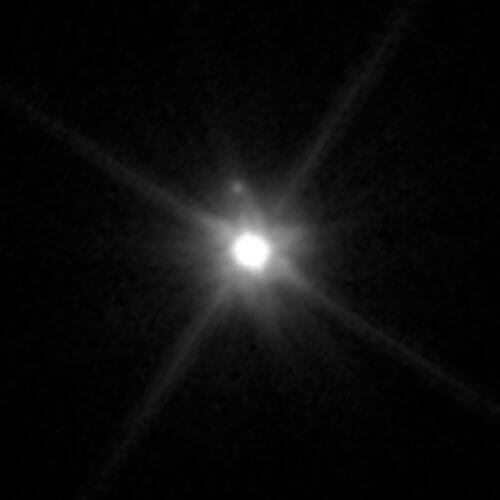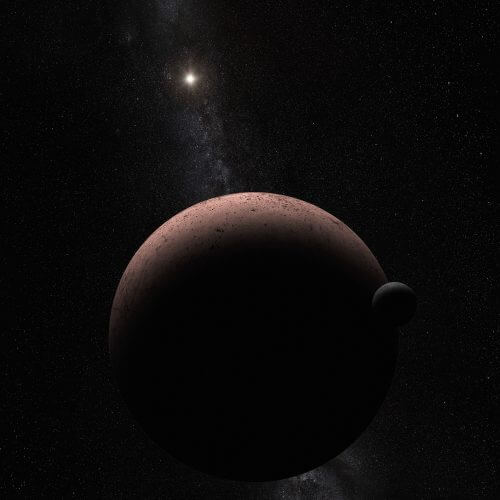The Hubble Space Telescope has discovered a new member of the solar system - a small moon orbiting the dwarf planet Maka-Maka, located in the Kuiper Belt at the edge of the Solar System.

The Hubble Space Telescope may be getting old and has already completed 26 years of operation, but it is still yielding fascinating discoveries about our solar system. Now it is announced that the telescope has discovered a new member of the solar system - a small moon orbiting the dwarf planet Maka-Maka, which is in the Kuiper belt at the edge of the solar system. The discovery puts Maka-Maka, which until now was considered unusual because it had no known moon, in line with the other dwarf planets in the outer solar system – Pluto, the Omiya and Eris, which all have moons.
Images from the Hubble Space Telescope have revealed a small moon orbiting Maka-Maka, named after the Maka-Maka god of the Easter Island native culture (because it was discovered in 2005 at the time of the Christian Easter). Maka Maka is a dwarf planet similar to Pluto, from which we were privileged to receive rich information last year. It is smaller than Pluto, with a diameter of about 1,430 km. It orbits the Sun at a distance ranging from 52 to 38 astronomical units (one unit is the average distance of the Earth from the Sun).
The diameter of the newly discovered moon is estimated at about 160 km (100 miles). The moon has been given the temporary name S/2015 (136472) 1, and is called by the researchers MK 2.
The photographs in which the moon was discovered were taken by the Hubble Space Telescope on April 27 and 29, 2015, andResults of the study have now been published by the team of researchers from the "Southwest Research Institute" (Southwest Research Institute) in Texas, United States.
The moon was clearly identified in the first photographs taken on April 27, but in the subsequent photographs taken two days later, the researchers were unable to identify it again, and neither were the photographs from previous years taken by the Hubble Space Telescope, whose quality was supposed to be sufficient to identify the moon. The reason for this, according to the researchers, is that the orbit of the moon is, from the point of view of the observer on Earth, perpendicular to the dwarf planet, so it is very difficult to separate the dwarf planet and its moon.
Since only a few observations were made, the researchers were unable to determine the exact orbit of the moon, and further observations will help with this.
The great importance in the discovery of the moon is that the orbit of satellites makes it possible to accurately determine the mass around them. So far the exact mass of maca-maca is unknown, and this figure is necessary to determine the density of maca-maca. Without the density figure, it is impossible to examine whether it is made of the same materials that make up Pluto.
The "new" moon makes Maka-Maka even more similar to the other dwarf planets in the Kuiper belt - Pluto, the Omiya and Eris, all of which have at least one moon.

Determining the exact orbit of the moon will also make it possible to determine, according to the researchers, how it was formed. The researchers put forward two options regarding the meaning of the orbit: if the moon's orbit is circular and relatively close to Maka-Maka (at a distance of 21,000 km or more, and an orbital duration of 12.4 days or more), then it was probably formed as a result of a collision between Maka-Maka and another celestial body ; If its orbit is elliptical and more distant, then it was probably captured by the gravity of Maka-Maka, sometime in the early period of the solar system. According to the researchers, the more preferred option is the first option, because in a circular and close orbit it will be more difficult to detect the moon, which would explain why it was not detected in previous observations by the Hubble Space Telescope.
The new moon may answer one of the mysteries related to maca-macca. Maka-Maka is the second brightest object in the Kuiper Belt, second only to Pluto. Thermal observations made in previous years using the Spitzer and Herschel space telescopes identified at least two distinct regions in front of the dwarf planet that are warmer than their icy surroundings. However, this discovery should also have indicated that with Maka-Maka's self-rotation, its brightness would be more varied, something that was not observed.
The researchers who discovered the new moon claim that it may be the explanation for this mystery - and not hot areas on the dwarf planet. To reconcile this with the thermal observations, the researchers suggest that the entire surface of the moon is very dark, unlike the very bright surface of Maka-Maka.
see also:
- According to the researchers on the Hubble Space Telescope website
- For the full article on the MK 2 moon discovery

8 תגובות
Lorem,
Exactly, I thought it was obvious, I was talking about the first shot above.
I think it can be determined that in his question Yariv meant the photograph (the one under which it says "the photograph in which we were discovered...") and not the imaging (the one under which it says "imaging...").
To Judah
Happy about the addition of a new commenter named Yehuda and suggests adding something else to his name to avoid confusion.
Offer only.
Successfully
Sabdarmish Yehuda
to the opponent
The shining thing is the sun. The moon is the thing next to Maka Maka on the right side in the simulation drawing.
There is only one problem that seems to me that at least one more verification is needed to mark the discovery.
Quote: "The moon was clearly identified in the first photographs taken on April 27, but in the subsequent photographs taken two days later, the researchers were unable to identify it again." End quote.
But NASA "as usual" rushes to take credit and at most will apologize later "as usual".
Good night
Sabdarmish Yehuda
Thanks, although it seems that the strong glare from the big planet only blinds and interferes with seeing the small planet next to it. It was interesting to see the intermediate stages of light collection, i.e. what it looks like after they have collected 50% of the amount of light, or 75%.
It looks very bright because a lot of light was collected for the purpose of photography, this is manifested in a very long exposure time, and electronic amplification of the signal. It was necessary to collect a lot of light for the purpose of the image to also allow the moon, which reflects a relatively small amount of light, to be seen. If less light were collected, it would be less luminous, but the moon would be indistinguishable.
They say it is only brighter than Pluto. Maybe because of the materials it is made of?
Why is this planet so bright in the picture as if it were a sun? Does anyone know?